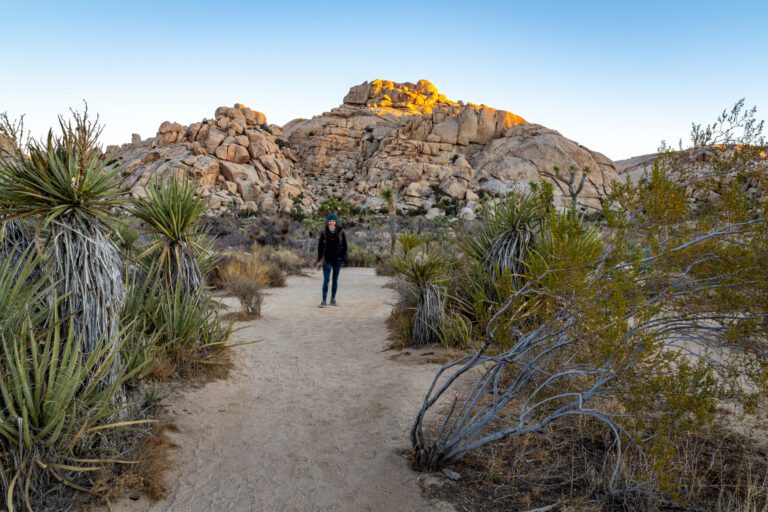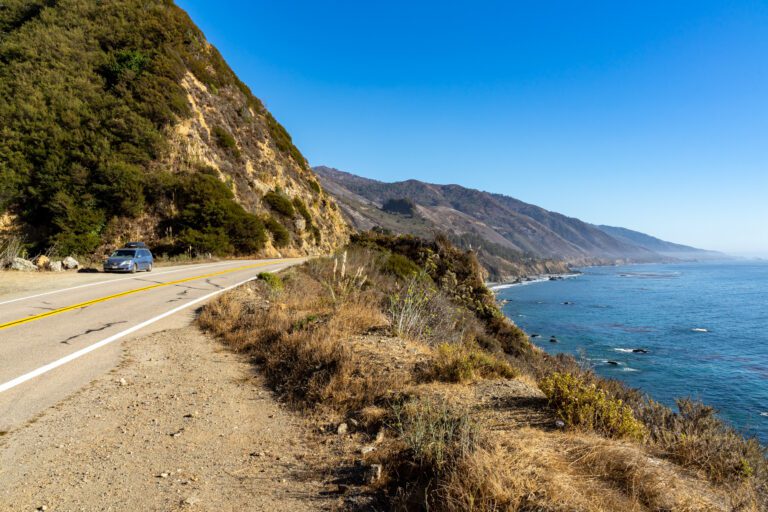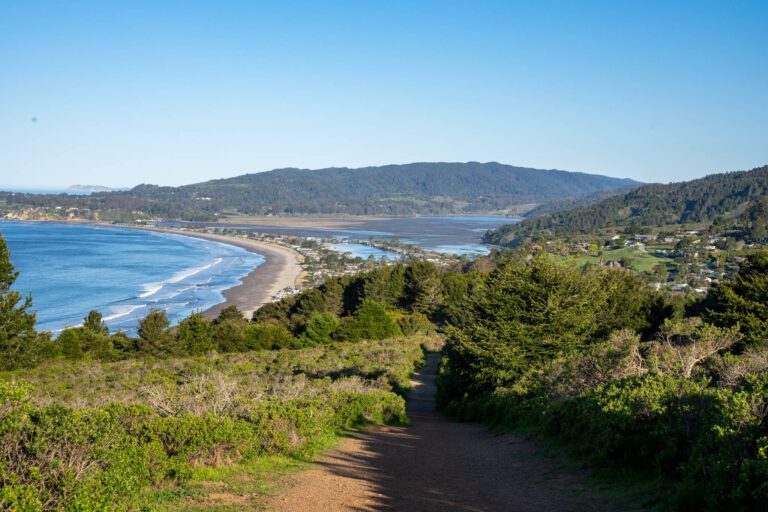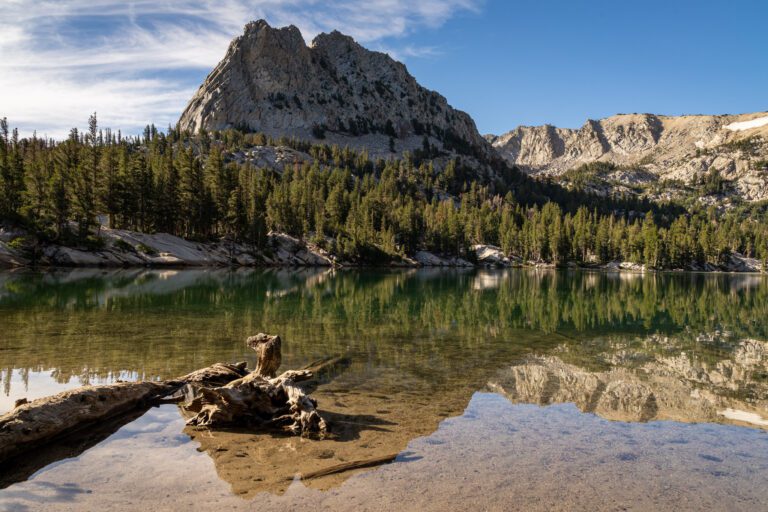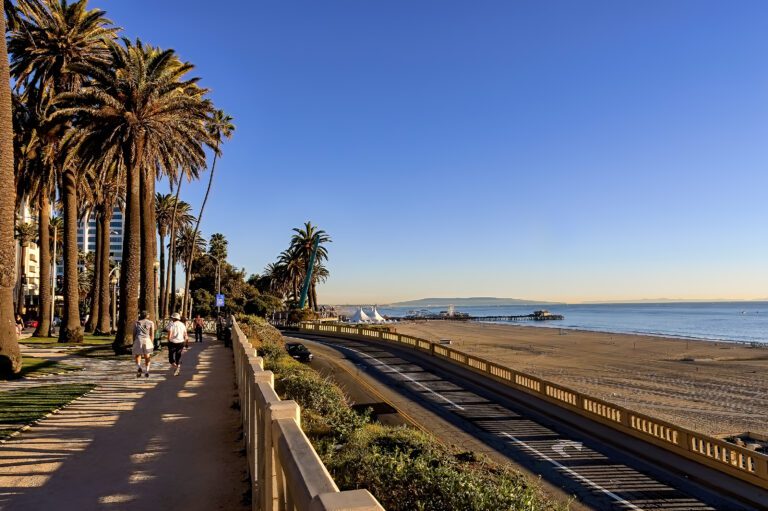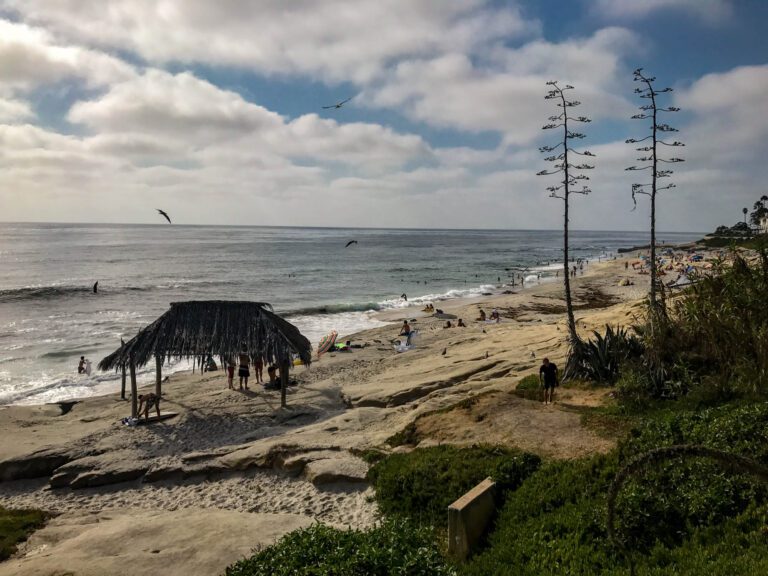2 Days in Yosemite: How to Plan Your Yosemite Itinerary
Yosemite National Park is one of the most famous and popular national parks in the country, and deservedly so, as it’s a stunning natural wonder. Nestled in the Sierra Nevada Mountains, and spanning more than 1,000 square miles, this UNESCO World Heritage Site is famed for its granite peaks and monoliths, stunning vista points and scenery, impressive waterfalls, pristine alpine lakes, scenic meadows, giant sequoias, world-class rock climbing, and hundreds of miles of epic hiking trails.
It’s an inspiring place, and one you will want to visit over and over.
This 2 day Yosemite National Park itinerary is based on my experience having explored Yosemite for more than 20 years. It will help you make the most of your time by covering the key highlights of the park in a way that makes logistical sense.
Plus it gives you the helpful information to make your 2 days in Yosemite National Park successful – where to stay, how to get around, what to do with more or less time, and more.
PS: Planning a trip to Yosemite? Don’t miss our detailed guide to where to stay at Yosemite National Park to help you find the perfect place to stay.
2022 Note: While entrance reservations are no longer required, you’ll want to confirm road status and campground statuses before your trip. There are a variety of closures for improvements, including a full closure of Glacier Point Road (more information here) and various campground closures (more information here).

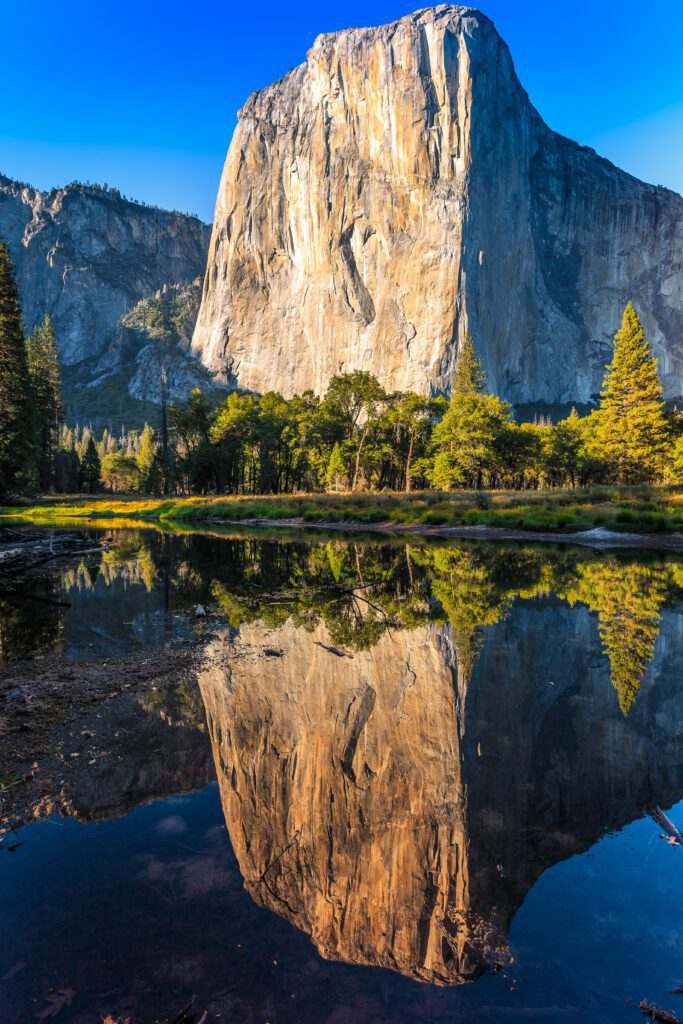
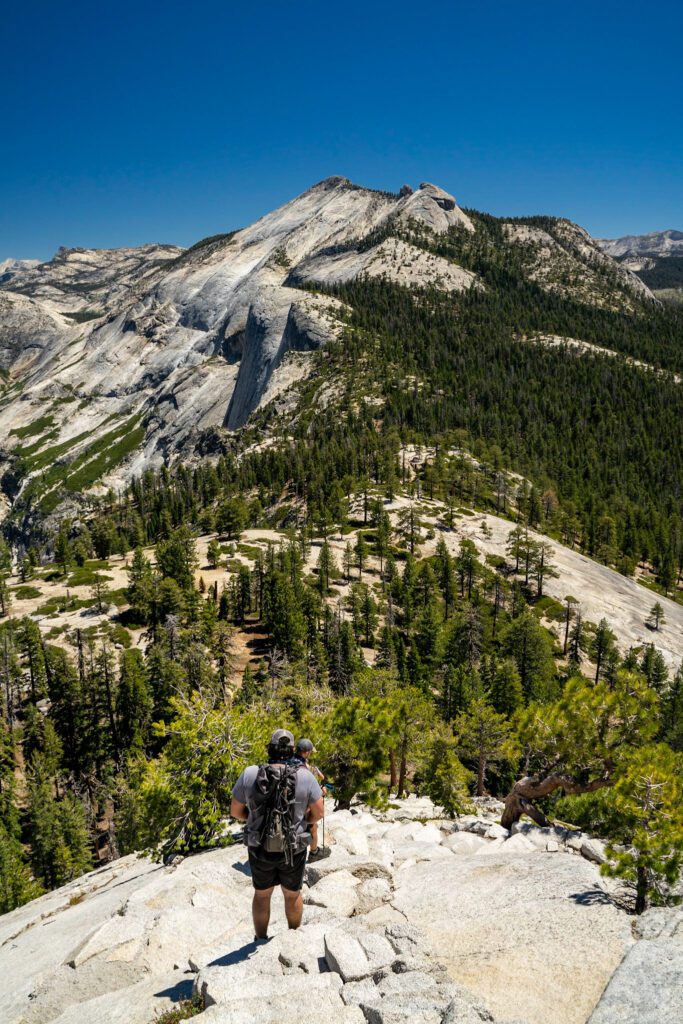
Disclaimer: Some of the links in this post, like hotel and vacation rental links, are affiliate links, meaning at no additional cost to you we make a little bit of money if you click through and book. That being said, we would absolutely never recommend something to you that we don’t stand behind 100%.
Tips for Planning a Trip to Yosemite National Park
Before we get into the itinerary for Yosemite, let’s cover some basics that you’ll need to know for your trip.
- Entrance fees: Entering the park will cost $35 per car. The America the Beautiful annual pass is a great value for anyone planning to visit three or more national parks a year.
- Mind the one way roads. Southside Drive (heading east) and Northside Drive (heading west) in Yosemite Valley are one-way roads. To avoid unnecessary backtracking, plan your route out ahead of time. Plan to arrive at the park early for parking and to beat the crowds, especially over the summer and on weekends.
- Be prepared. Bring plenty of water, snacks, and wear sun protection and sturdy footwear with good traction when hiking. Do not drink water from streams or lakes without purifying it first. Mosquito repellent is also a good idea, especially over the summer. Be careful of altitude if coming from sea level or lower elevations.
- Be bear aware. Hundreds of black bears live in Yosemite. Travel the speed limit and secure your food and anything else with a smell in your locked vehicle during the day, and in bear-proof lockers at night. Use bear-proof canisters in the backcountry. Failure to secure food can lead to hefty fines and may result in a bear having to be killed. Bear spray is not permitted in the park.
- Do not approach or feed wildlife. Especially squirrels and other rodents that may carry the plague and hantavirus.
- Afternoon thunderstorms can occur in the summer. Be careful of lightning. Avoid exposed ridges and do not climb any domes when lightning is nearby.
- Cell coverage is very limited in the park. It’s best to have paper maps or download maps onto your phone ahead of time.
- Carry chains, and know how to use them if you’re traveling between November and April, even if you’re driving a 4WD or AWD vehicle.
- Pack a lunch. There are several options for eating and drinking inside the park. They are largely overpriced and not the best quality, but the convenience is certainly a plus. If you can, pack a lunch that you can enjoy on the go.
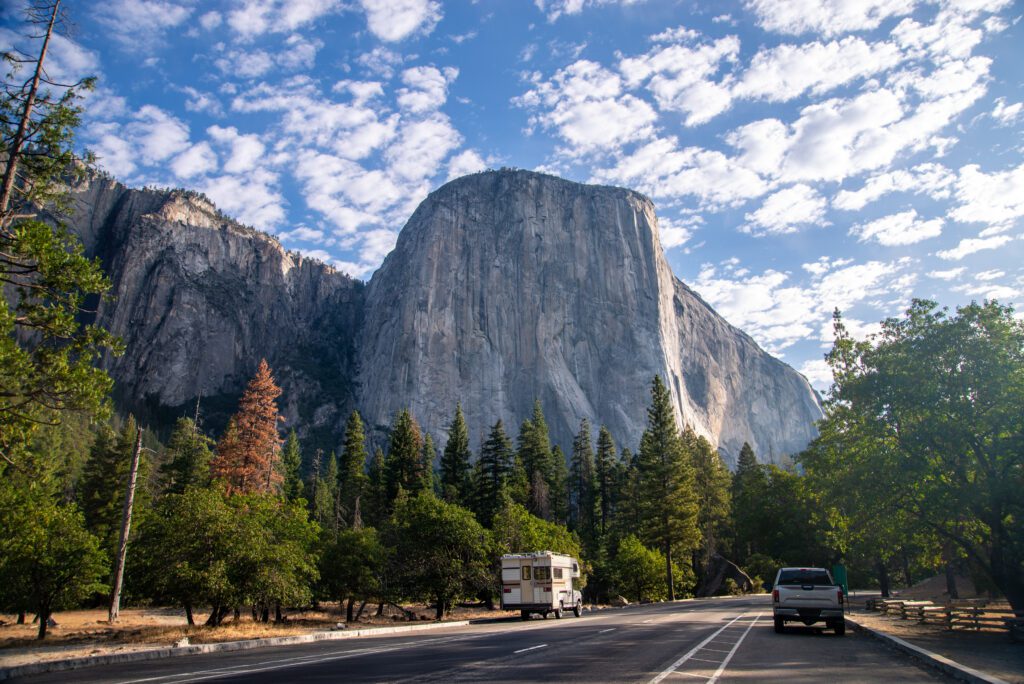
Where to Stay in Yosemite National Park
The biggest thing to know here is that you should make your reservations as early as humanly possible, wherever you end up choosing to stay. But especially if you want to stay in the Valley, where there are few options.
We have an entire guide dedicated to helping you find the right place to stay in Yosemite National Park. For more detail on each region, including the pros and cons for each area, you’ll definitely want to head there.
Hotels in the Park
For those who would prefer not to rough it, but still want to be close to everything, there are several lodging options inside the park, from grand historic hotels to more basic canvas tent cabins.
They are very popular and can book up a year in advance for peak season.
Inside Yosemite Valley
There are a few places to stay inside the Valley, but they are very competitive, and you’ll pay a premium for the convenience and privilege of being within walking distance of everything there is to do and see in the Yosemite Valley.
You will quite literally have to book a 9-12 months in advance to have a shot at staying at these places on a weekend (and it’s not like midweek is particularly less competitive – maybe only 6-8 for that).
- The Ahwahnee: This National Historic Landmark is worth the splurge. Located near the base of Half Dome and Glacier Point, the majestic stone lodge features soaring ceilings, grand lounges, and massive fireplaces. Ask for a room on a higher floor for the best views or a cottage for more privacy. Even if you don’t stay here, stop in for a view of the Great Lounge, a bite in the restaurant, or a drink at the bar.
- Yosemite Valley Lodge: Spread out across several buildings, the rooms at Yosemite Valley Lodge are basic with a rustic wooden décor, but you’re mostly paying for the location across from Yosemite Falls. Several trails are also nearby. There are a variety of food options, a bar, pool, hot tub, grocery store, and other amenities.
- Curry Village: Located off Southside Drive across the river from Yosemite Village, Curry Village offers hundreds of canvas tent-cabins (with or without heat), cozy wood cabins (with or without bathrooms), and motel-style rooms in Stoneman House.
- Housekeeping Camp: Perched along the Merced River with a sandy beach nearby, stay in three-sided concrete structures with canvas roofs and privacy curtains. Bring bedding or rent them for your stay. Open seasonally between April and October.
Elsewhere in the Park
There are a few other places to stay inside the park.
- High Sierra Camps: Enjoy backpacking without having to carry a tent with a stay at one of five camps with canvas tents in the High Sierra. Camps are spread out on a loop from 7,150 feet (Merced Lake) to 10,300 feet (Vogelsang). May Lake is the easiest for access, while Glen Aulin and Sunrise offer the best views. Hike in or ride a mule. Beds and meals are provided, and a few also offer showers. Open seasonally.
- Wawona Hotel: Located in the southern part of the park, 25 miles from the valley, this historic hotel offers rooms (with private or shared bathrooms) in whitewashed Victorian buildings with grand verandahs. Amenities include restaurant, lounge and seasonal pool, golf course, and riding stables. Open seasonally.
- White Wolf Lodge: Located near Tioga Road, 30 miles from the valley, this remote and tranquil lodge consists of basic wood and canvas-covered tent cabins, a few traditional cabins with bathrooms, and a central dining room for meals. Open seasonally.
- Tuolumne Meadows Lodge: Located near the park’s east entrance next to the Tuolumne River, 60 miles from the valley, expect basic canvas tent cabins with shared bathrooms, and a dining tent for hearty meals. Open seasonally.
- In the winter, ski touring visitors can stay at the Glacier Point Ski Hut and Ostrander Ski Hut.
Staying Outside the Park
There are options near all the entrances to the park. However, they will all be some distance from the valley, with a drive time of an hour in some cases.
However, if you’re on a budget OR you’re planning within a couple of months of your trip, this is your best bet.
Here are some of the top lodging options outside the park.
- Yosemite West: Although technically inside the park, the private community of Yosemite West is still at least 15 miles from the valley. Vacation rental houses and condos are available. Despite the name, access is from the south entrance of the park, off Wawona Road.
- Tenaya Lodge: Located in Fish Camp, just outside the park’s south entrance, choose from spacious hotel rooms, cottage rooms, or private cabins. Amenities include restaurant, bar, four pools and hot tubs, spa, climbing wall, kids adventure course, and guided tours.
- Yosemite View Lodge: Located less than 9 miles from Arch Rock entrance of the park on El Portal Road, and 15 miles from the valley, this convenient hotel is situated right along the Merced River. All rooms include a kitchenette and the hotel offers four pools and a hot tub, restaurant, and bar.
- Rush Creek Lodge: Located just outside the Big Oak Flat entrance to the park on CA-120, and 25 miles from the valley, choose from hotel rooms or hillside villas tucked in the woods. Enjoy a pool, hot tub, playground, restaurant, tavern, and general store. It’s a sister property to the Evergreen Lodge.
- AutoCamp Yosemite: Located on CA-140 north of Mariposa, about 35 miles from the valley, you can glamp in style in a cute cabin, luxury tent, or vintage airstream. There’s also a clubhouse, fire pits, seasonal pool, freshwater pond, and loaner bikes to ride around the property.
- Evergreen Lodge: Located in Mather, on the road to Hetch Hetchy, and 30 miles from the valley, this rustic resort offers cozy cabins and, over the summer, furnished tents as well. There are plenty of amenities, including pool, restaurant, bar with live music, rec center, playground, amphitheater, and gift shop.
Camping in the Park
Camping in Yosemite is one of the best ways to experience the park. There are 13 developed campgrounds inside the park offering nearly 15,000 campsites.
Five campgrounds are open year-round, while the rest are seasonal between April, May, or June to October or November.
Campsites can be booked five months in advance on the 15th of each month at 7:00 am PST.
The following campgrounds are great, and should be booked well in advance (where applicable).
- Upper Pines: With 238 sites including RVs, it’s the largest campground in the valley. Enjoy filtered valley views, a decent amount of shade, and easy access to trails. Sites are close together so there won’t be much privacy, but its convenience and location right in the heart of the valley make up for it. Open year-round.
- Lower Pines: Located along the southern banks of the Merced River, the seasonal Lower Pines offer 60 sites, including RVs. Sites are pretty packed in and lively and there are great views of Half Dome, but some sites are prone to flooding in the spring when the river is high.
- Camp 4: Close to El Capitan and with a large boulder onsite, Camp 4 is legendary among the climbing community. 35 sites are split among six people at this walk-in, tent-only campground. It can get pretty rowdy here so avoid it if you’re looking for peace and quiet, or you’re not a climber. Reservations are by lottery (open midnight to 4:00 pm) one day in advance. Pets are not allowed.
- Wawona: The southernmost campground in the park, this campground is located near the Merced River, Wawona Hotel, and store. It’s ideal for accessing Mariposa Grove, though it’s still a 27 mile and 45-minute drive from the valley. 93 sites are available, including for RVs. Open year-round.
- Bridal Veil Creek (NOTE: closed for renovation through 2022): Located at 7,200 feet on Glacier Point Road, it’s well placed for accessing Glacier Point and the various hikes in the area, though far from the valley (at 26 miles and 45 minute drive away). There are 112 sites here, including for RVs, groups, and horses.
For backpacking and overnight stays in the wilderness in Yosemite, a wilderness permit is required. There are a limited number available, and they must be applied for in advance.
2 Days in Yosemite National Park: How to Plan an Amazing Yosemite Itinerary
This itinerary assumes you have two full days to explore the park. If you have more or less time to visit Yosemite National Park, we have suggestions for you below the main itinerary.
Even with one day in Yosemite, you can still enjoy many of the top highlights of the park, several hikes, multiple waterfalls, and scenic viewpoints and overlooks. Though there is still plenty to do and see with more time.
Day 1: Yosemite Valley and Waterfalls Galore
You’ll spend your first day exploring the main highlights of Yosemite Valley, which includes several iconic waterfalls.
Bridalveil Falls
This is the first major waterfall you see as you enter the valley, and one that will be flowing year-round. It’s a short quarter mile paved trail to the base of the falls.
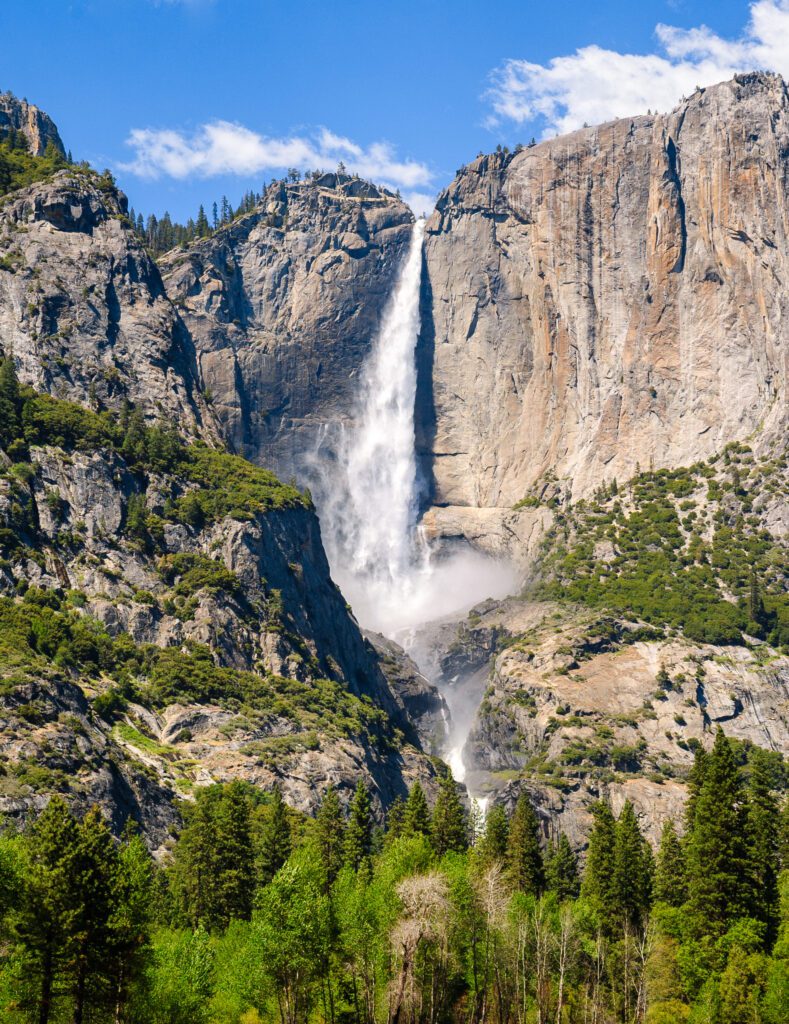
The rocks at the base are very slippery and should not be climbed. In the spring the falls will be roaring, and you can get wet near the base.
At other times of the year, when the wind picks up and moves the water from side to side, you see why the Ahwahneechee people called it Pohono, or Spirit of the Puffing Wind.
Sentinel Beach or Sentinel Bridge
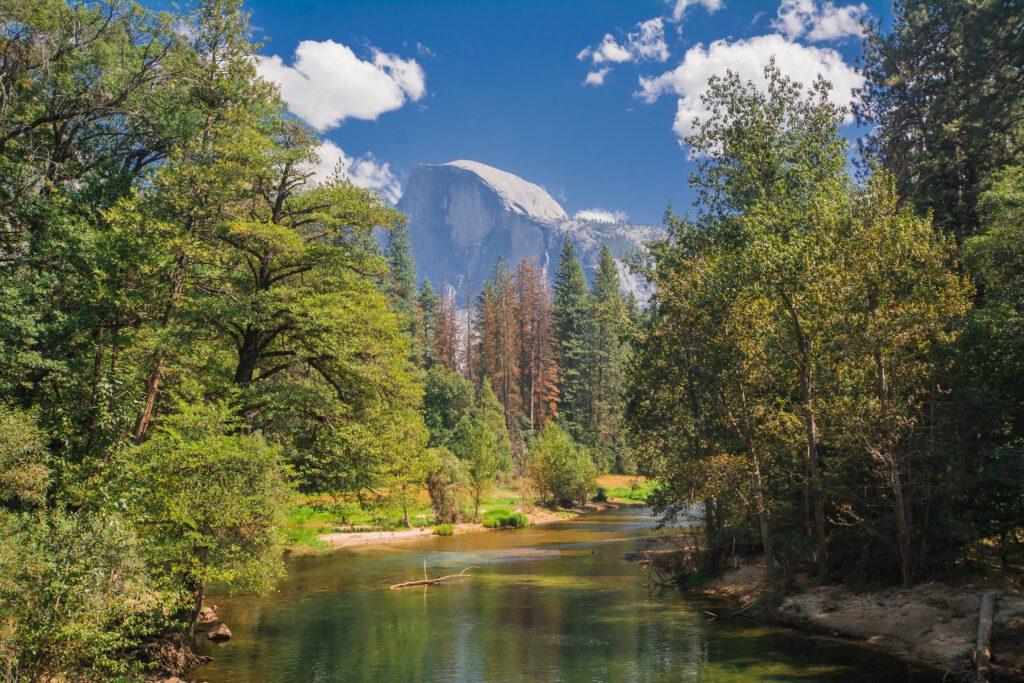
If you’re visiting in the summer, stop at Sentinel Beach for a cool dip in the Merced River. There’s also a picnic area where you can enjoy a snack. Stop by the nearby Swinging Bridge as well for great views of Yosemite Falls.
Further along Southside Drive, stop at Sentinel Bridge for great views and photos of Half Dome reflected in the waters of the Merced River.
The Mist Trail
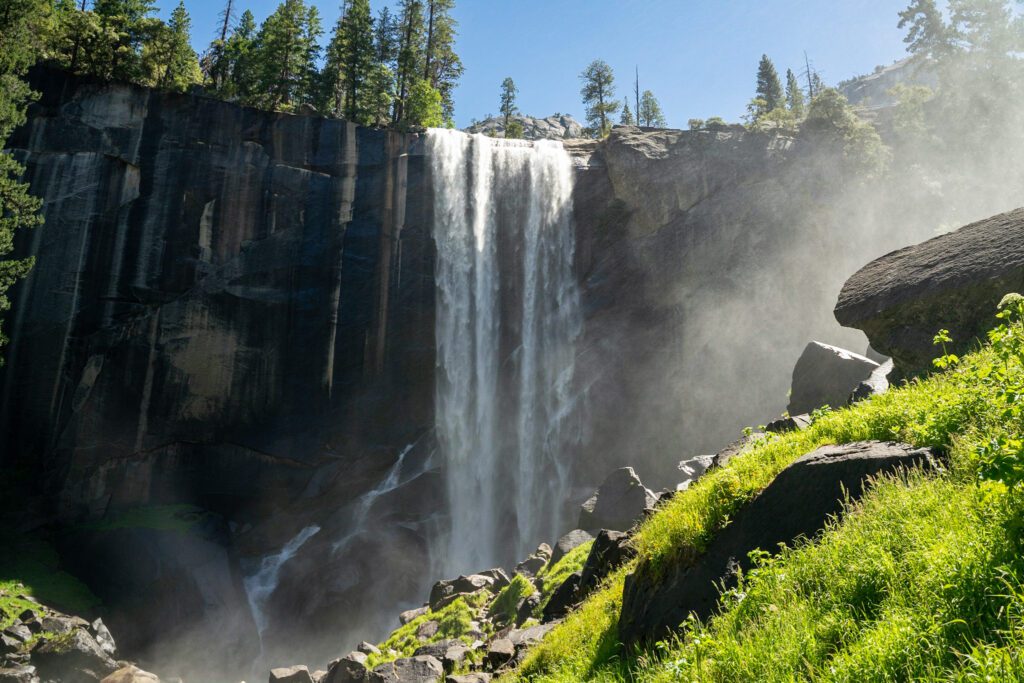
If you do just one hike in Yosemite, make it this one, which lets you see four waterfalls, including getting close enough to two to get wet from the spray (in the spring).
From the Happy Isles shuttle stop, it’s less than a mile to the Vernal Falls footbridge. Climb up the steep granite steps to the top of Vernal Falls, where the Emerald Pool and Silver Apron are located.
Continue up to the top of Nevada Falls, then come back down along the John Muir Trail.
If you’ve brought a picnic lunch, enjoy it at the top of either falls. Otherwise, wait until you are down in the valley to grab some food, with grab and go, fast casual, and fine dining options available.
More trail information here.
Yosemite Falls
Complete a waterfall trifecta with a visit to Yosemite Falls. It’s considered the highest waterfall in North America at 2,425 feet, even though it’s technically three separate falls.
There’s an easy 1 mile loop trail that takes you to the base of Lower Yosemite Falls. The trailhead for Upper Yosemite Falls can be found near Camp 4.
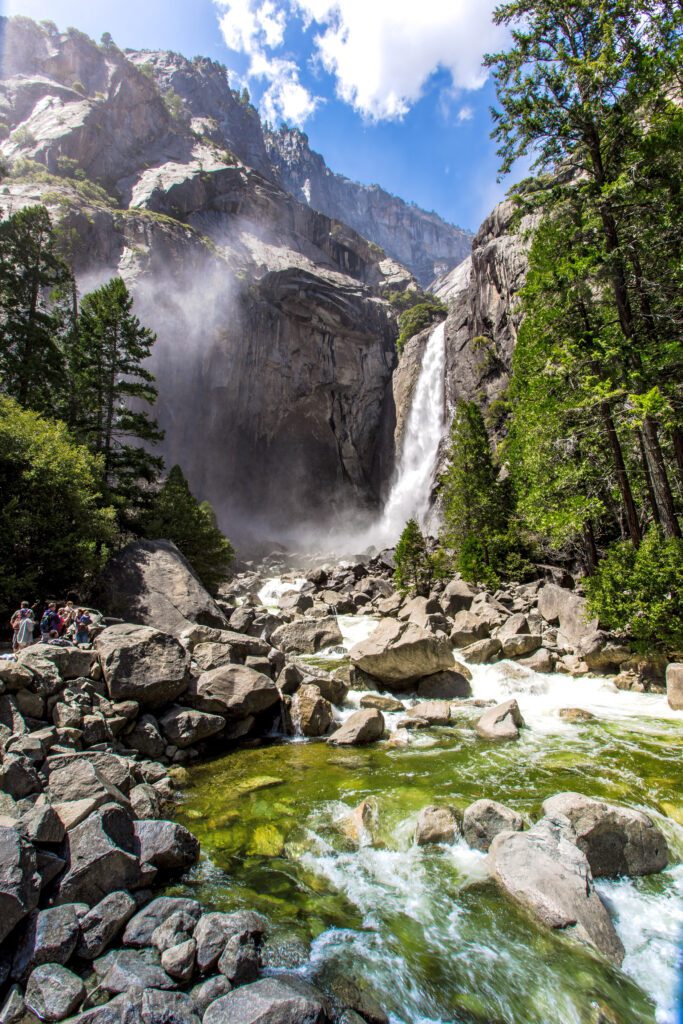
You likely won’t have time to make it all the way to the top, but it’s worth hiking up the first 1.2 miles and 1,200 feet to Columbia Rock if your schedule allows.
El Capitan Meadow
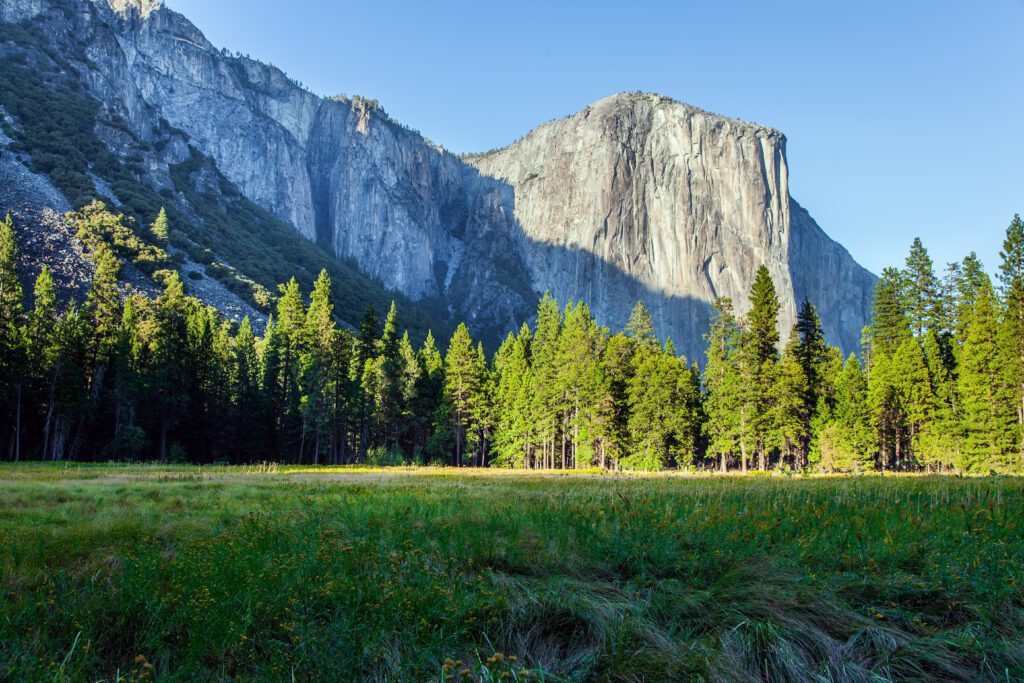
Enjoy great views straight up the massive granite monolith of El Capitan, towering 3,593 feet above the valley floor and of Cathedral Rocks, at El Capitan Meadow (here on Google Maps).
Bring binoculars or stop at nearby El Capitan Bridge for the seasonal “Ask a Climber” program. Telescopes are often set up for you to get a closer look at climbers’ progress and you can chat with a Yosemite Climbing Ranger.
Valley View
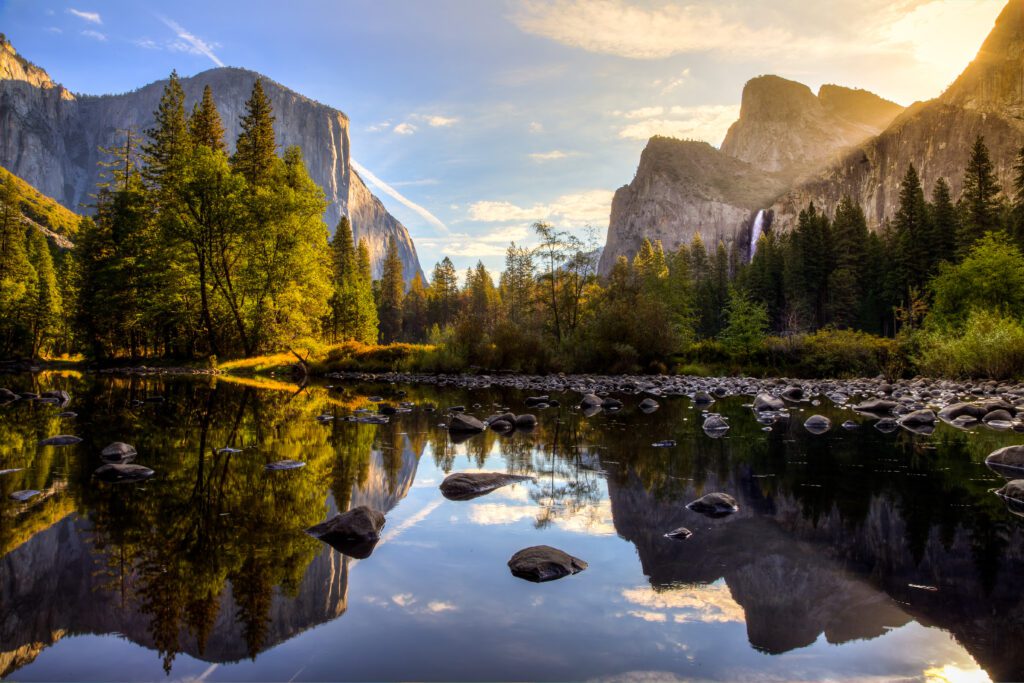
End your day with sunset at Valley View, located on Northside Drive just before Pohono Bridge (here on Google Maps). It’s one of the iconic views of the valley, with El Capitan, the Cathedral Rocks and Spires, Bridalveil Falls, and the Merced River in the foreground.
Afterwards, stop by the Ahwahnee for a drink or meal. If it’s clear out, you may want to spend some time stargazing as well.
Day 2: Giant Sequoias and Scenic Viewpoints
Spend your second day admiring giant sequoia trees and several incredible panoramic viewpoints in Yosemite.
Mariposa Grove
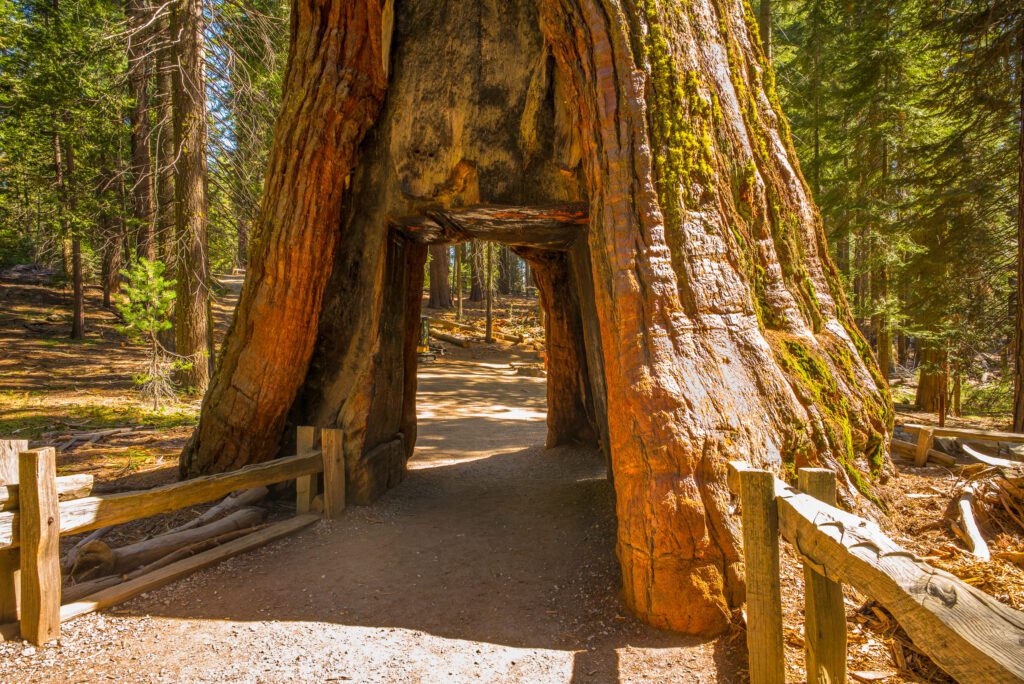
Just past the Wawona entrance, Mariposa Grove is the largest of three sequoia groves in the park, and features hundreds of mature and smaller trees.
The most famous is the massive Grizzly Giant, at 210-feet tall and more than 100 feet in circumference. A 2 mile loop of the lower grove takes you past the Grizzly Giant and other famous trees.
You can also explore the upper grove, which adds 4 miles to your hike, and takes you past Mariposa Grove Museum – more trail information here.
Wawona Hotel
Stop for a late breakfast or an early lunch and a peek inside the historic Victorian-style Wawona Hotel.
There’s also a Visitor Center across from the hotel. History buffs should also cross the covered bridge and stop in at the Pioneer Yosemite History Center. If you’ve packed a lunch, feel free to enjoy it later on at one of the overlooks.
Tunnel View / Inspiration Point
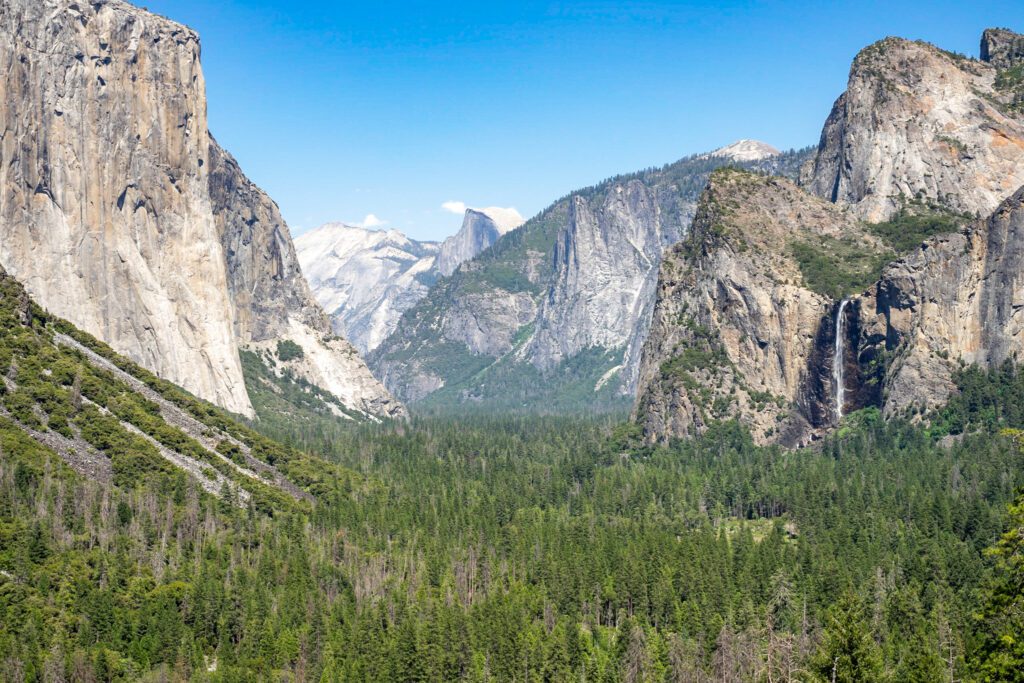
Made famous by photographer Ansel Adams, Tunnel View is one of the most famous viewpoints in the park. Located just outside the eastern end of Wawona Tunnel, it features a classic view of El Capitan, Half Dome, Cathedral Rocks, Sentinel Rocks, and Bridalveil Falls.
It’s a popular viewpoint and the parking lot may be full, especially around sunset.
To escape the crowds, consider taking the trail up to Inspiration Point.
Afterwards, head to Glacier Point Road.
Washburn Point
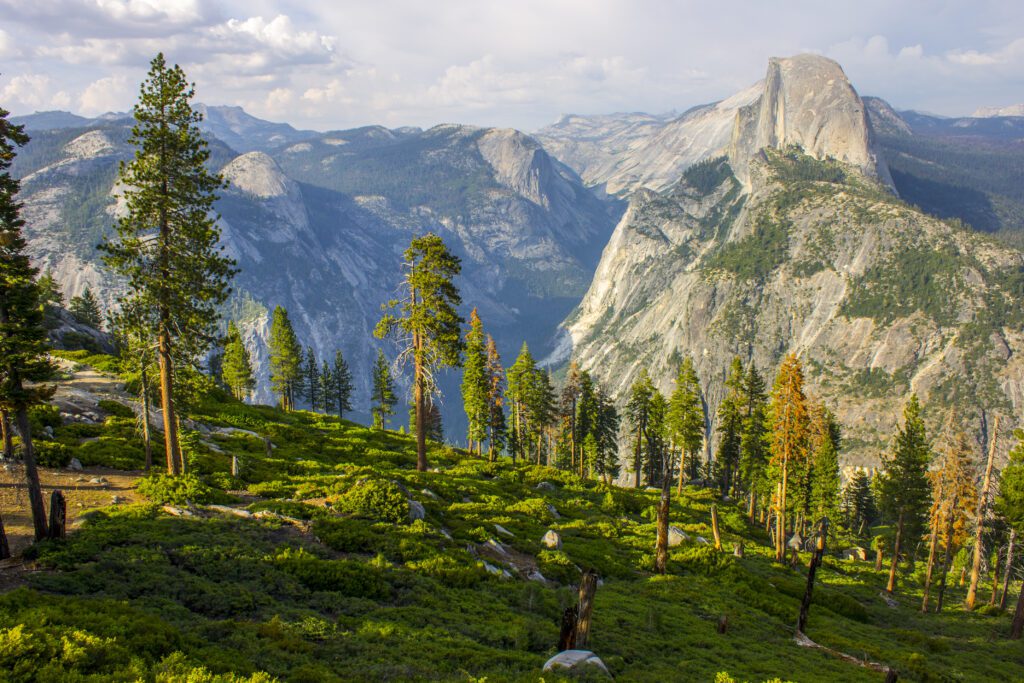
Just 1 mile from Glacier Point, make a quick stop at Washburn Point (here on Google Maps).
Named for the Washburn brothers who built the Wawona Lodge, this overlook provides views of Half Dome, Vernal and Nevada Falls, Illilouette Falls, and the eastern crest of Sierra.
Glacier Point
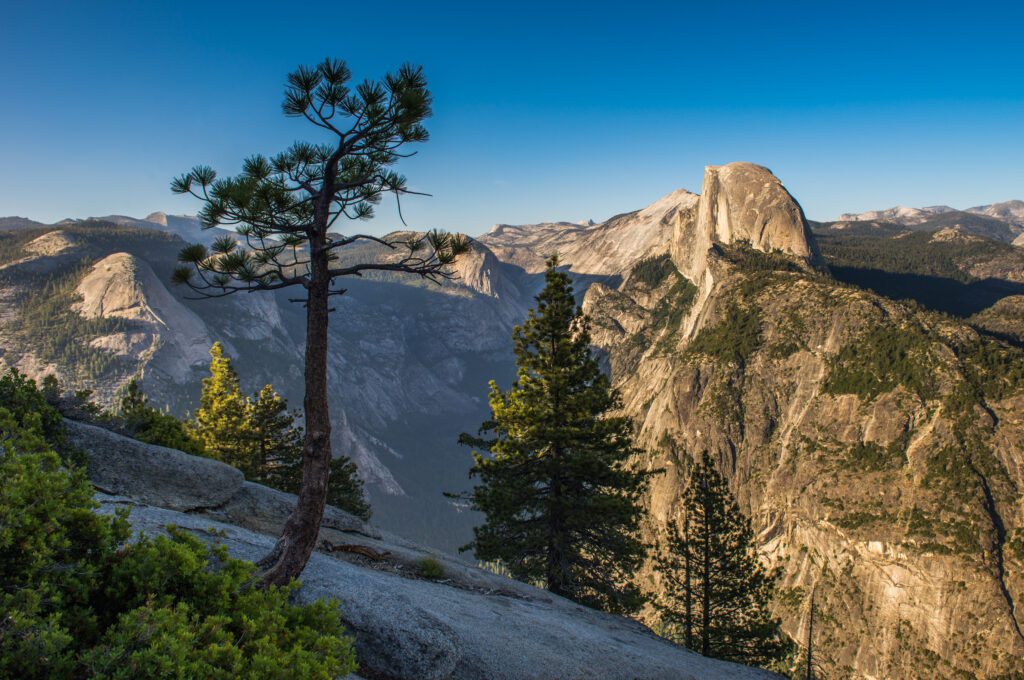
At 7,214 feet, and 3,214 feet above the valley floor, Glacier Point offers one of the best views of the park, a stunning panorama of Yosemite Valley, Half Dome, three waterfalls, Tenaya Canyon, and distant mountain peaks and domes.
It’s a quick walk from the parking lot to the overlook, where you can look straight down at the valley.
For those that want to earn their views, the Four Mile Trail from the valley floor is a good option. Or head down to the valley on the 9-mile Panorama Trail.
Glacier Point is a very popular sunset spot. Get here early to grab a good spot, or consider visiting at sunrise to beat the crowds.
If you’ve run out of time and sunset is fast approaching, stay put at Glacier Point. Otherwise, head back down the road a little ways for one final hike for the day.
Sentinel Dome / Taft Point
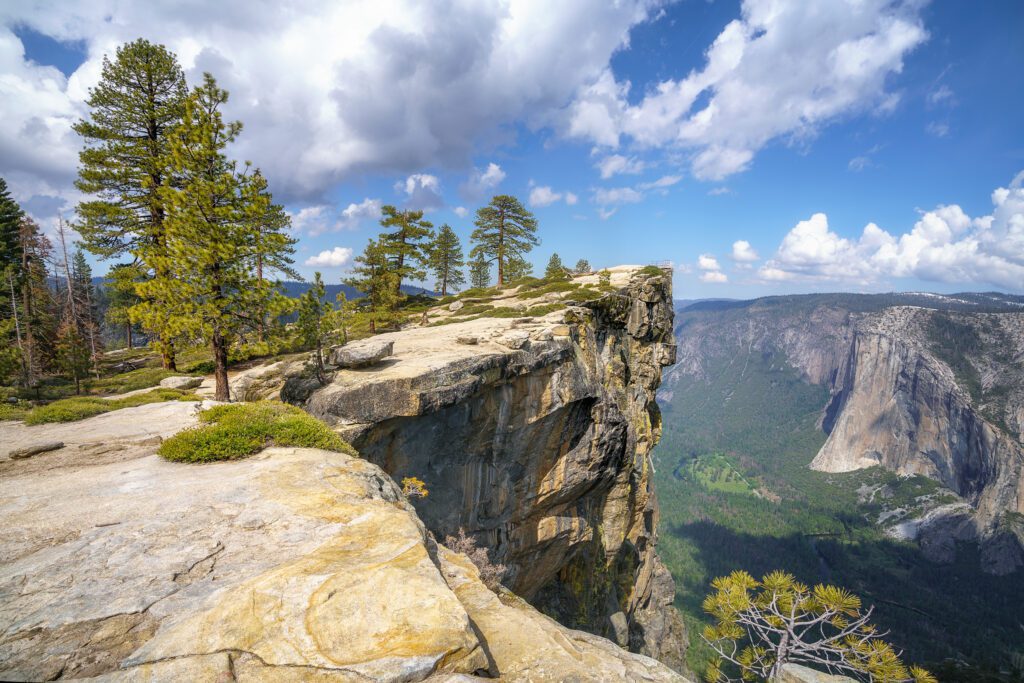
Located 2 miles from Glacier Point, the trailhead offers access to both Taft Point (take a left) and Sentinel Dome (take a right).
Both hikes are just over 2 miles round trip, or you can combine them for a 5-mile loop.
Both offer spectacular, though slightly different, views – enjoy 360-degree views from Sentinel Dome, while Taft Point offers sheer vertical cliffs, the fissures, and views straight down to the valley.
Both are popular for sunset, and there may be a wait for the best photo spots. Be sure to bring a head lamp for the walk back after sunset.
What to Do with 3 Days in Yosemite
Spend your third day exploring the Yosemite high country along Tioga Road.
Stop at Tuolumne Grove to explore another grove of sequoias (including the Tunnel Tree and Leaning Towering Tree). Next, stop at Olmsted Point for sweeping vistas of Half Dome and Tenaya Canyon. There’s a very short and easy hike to the point.
After Olmstead Point, glistening Tenaya Lake awaits. You can enjoy a cold dip in the waters, a hike around the lake, or look for climbers on the walls. At the far western edge of Tuolumne Meadows, take an easy stroll up Pothole Dome for lovely views over the meadow.
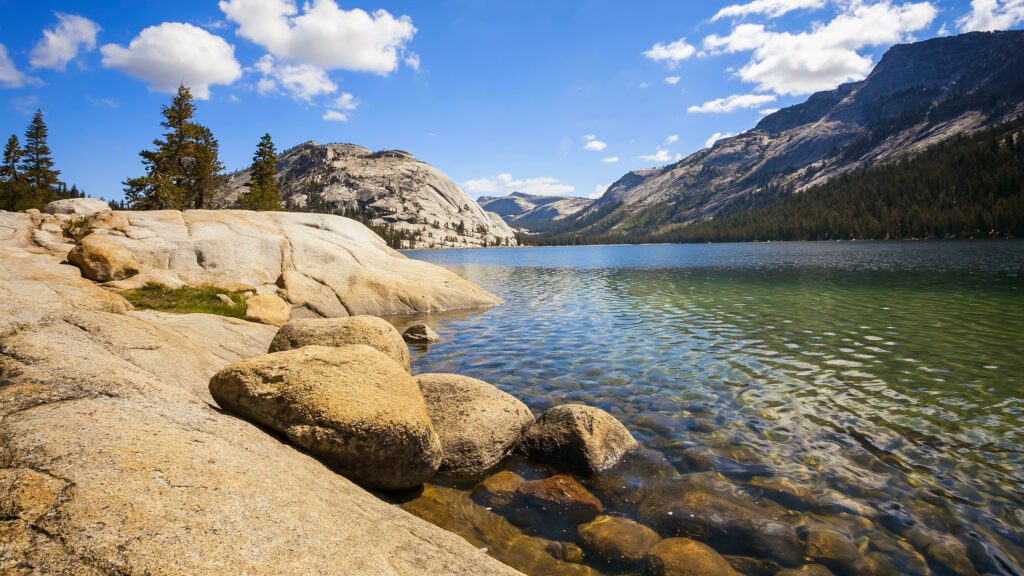
Spend some time enjoying the beauty of Tuolumne Meadows, the largest subalpine meadow in the Sierra and likely blanketed in wildflowers. Enjoy a picnic lunch or grab food at nearby Tuolumne Meadows Lodge or Tuolumne Meadows Grill. There is also a Visitor Center nearby.
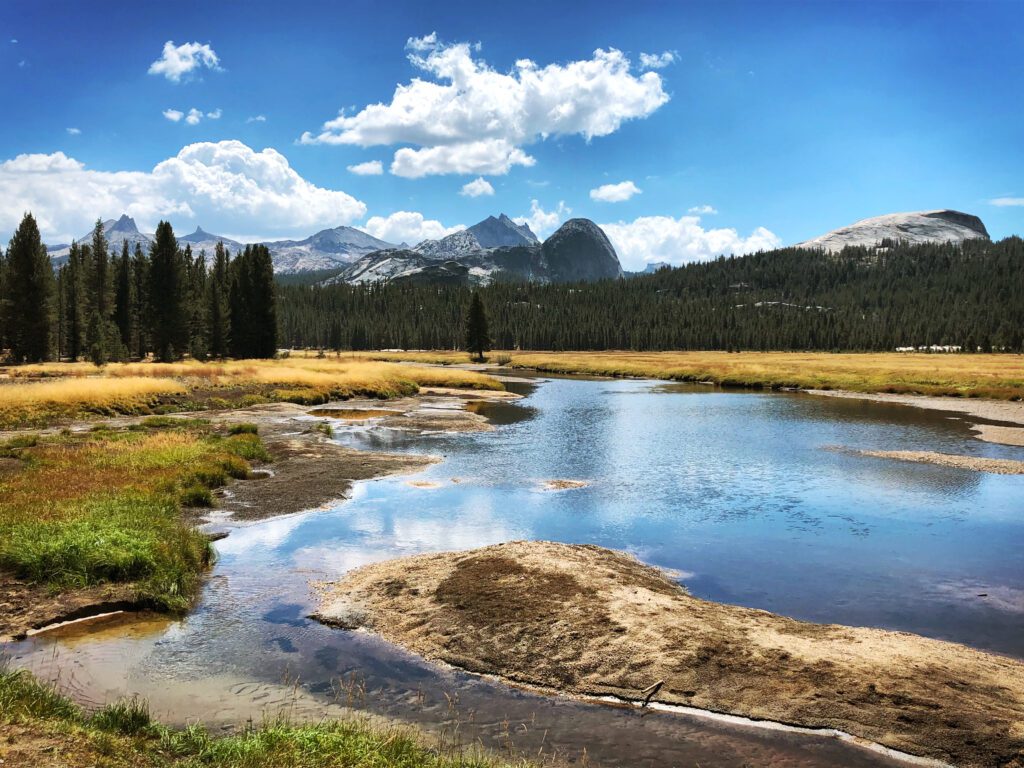
Afterwards, hike to Lembert Dome and Dog Lake (hike info here), or if you have more time and energy, stunning Cathedral Lakes (hike info here).
If you exit the park at Tioga Pass, continue on to Lee Vining and spend some time exploring the area, including highlights such as Mono Lake, June Lake, and Mammoth Lakes.
Stop for a bite at the Whoa Nelly Deli – an award winning deli inside a Mobil Gas Station – in Lee Vining. And take advantage of the many hot springs in the area.
Note: This itinerary for the third day only works when Tioga Road is open, typically between late May or June and November.
What to Add with Even More Time
Have even more time in the park? Here are even more things to do that you can add to your Yosemite National Park itinerary.
Hike Half Dome
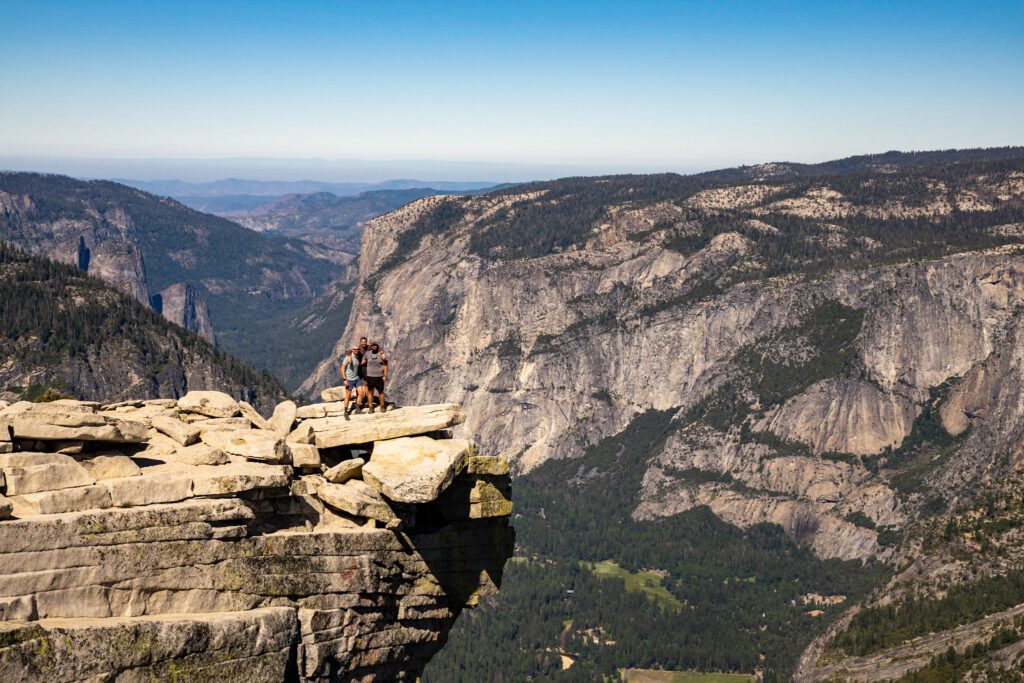
You’ll need to plan in advance, and have a bit of luck for this one, but it’s totally worth the effort as this is arguably the most iconic hike in all of Yosemite.
The trail is open between May and October and requires a permit. The lottery for permits opens in March, and only 300 hikers (225 day hikers and 75 backpackers) are allowed per day. There is also a daily lottery two days beforehand.
The hike is 16 miles round trip with 4,800 feet in elevation gain. Expect to take around 10 to 12 hours round trip.
Backpackers, including those staying the night at Little Yosemite Valley, should apply for a Half Dome permit when applying for their wilderness permit.
Hetch Hetchy
Similar in appearance to Yosemite Valley, Hetch Hetchy was flooded in 1923 to be a water supply for the city of San Francisco. You can expect solitude and spectacular views on a visit here.
Hike along O’Shaughnessy Dam, go chase waterfalls, like Tueeulala and Wapama Falls or Rancheria Falls, and look for wildflowers from late spring to summer.
Rock Climbing
Yosemite is a mecca for rock climbers, from bouldering to the ultimate in big wall climbing. The climbing season runs from April to October.
Popular areas include Yosemite Valley, with a base camp at Camp 4, and Tuolumne Meadows, with a base camp at the Tuolumne Meadows Campground. Both areas are good spots to find climbing partners and beta.
Beginners can take a course through the Yosemite Mountaineering School, which also offers more advanced classes and guided climbs.
To spot climbers, head to El Capitan Meadow, El Capitan Bridge (which also has an ‘Ask the Climbers’ program), Tenaya Lake, and Tuolumne Meadows.
Rafting
If you’re visiting between May and July, rafting along the Merced River is a non-strenuous yet scenic way to explore the park.
It’s more of a lazy drift than actual rafting, but the views of the granite walls more than make up for any lack of action. You can rent rafts near Curry Village or bring your own. Find the put-in point near the rental shop. Float down the river 3 miles and catch a shuttle bus back.
For a more thrilling rafting experience, head west on Hwy 140 outside the park west of El Portal for Class III and IV rapids.
Backpacking
There are more than 750 miles of trails to explore in the Yosemite Wilderness and spending a night or two backpacking is a great way to explore.
Head up to Tuolumne Meadows and hike to Grant Lakes or Ten Lakes, or take the Vogelsang Loop. Or, you could hike to Ostrander Lake.
For all the highlights of backpacking without having to carry all the heavy gear, consider staying at one of the five High Sierra Camps, which provide beds and meals.
What to Do with One Day in Yosemite
Even if you have just one day in Yosemite, you can still see many highlights in the valley, waterfalls, and spectacular viewpoints. You’ll definitely want to come back for a more leisurely visit, but here’s how to maximize your day, from sunrise to sunset.
Head to Tunnel View for sunrise with one of the most iconic views in the park.
Afterwards, head to the Bridalveil Falls trailhead, and take the short trail to the base of the falls.
Head along Southside Drive with a stop at Sentinel Beach and then Sentinel Bridge for views of Half Dome in the Merced River.
Afterwards, stop at the Visitor Center, and take the shuttle to Happy Isles to take the Mist Trail up to Vernal Falls, though you likely won’t have time to go to the top of Nevada Falls. More information on the hike here.
Drive to Cook’s Meadow next. The short trail offers great views of Yosemite Falls, Half Dome, Glacier Point, and Sentinel Rock. N
ext up is the short trail to Lower Yosemite Falls. Afterwards, head to El Capitan Meadow for a view straight up El Capitan plus great views of Cathedral Rocks. Bring binoculars to look for climbers on the wall.
Afterwards, head to Valley View, another classic viewpoint great for photos. Drive through Wawona Tunnel and drive on Glacier Point Road all the way to the end to Glacier Point.
You can watch the sunset here, or if you have extra time and energy, hike to either Taft Point or Sentinel Dome for sunset after Glacier Point.
5 Great Hikes in Yosemite National Park
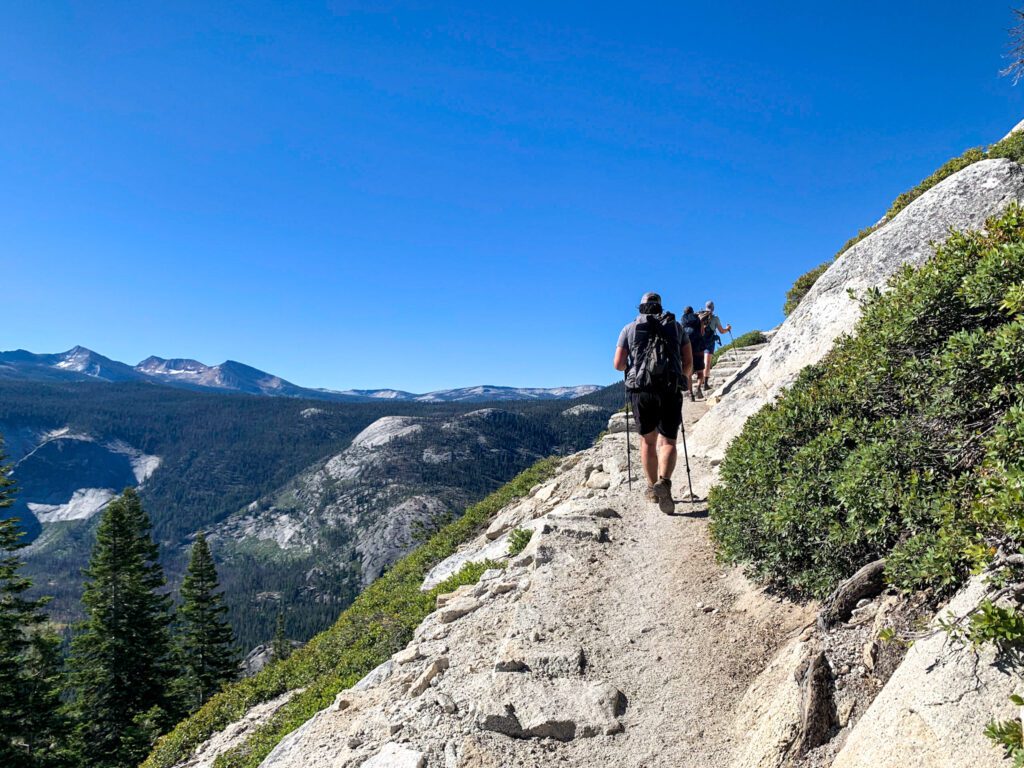
There are hundreds of trails in Yosemite, from day hikes to multi-day backpacking adventures. You can find everything from an easy and flat stroll to a thigh-burner of epic proportions. You can definitely earn your views here.
Here are a few top picks to start.
Backcountry hiking: Wilderness permits are required year-round for any overnight stays in the Yosemite wilderness. There are quotas for each trailhead, 60 percent of which can be reserved in advance, with the remainder two weeks and up to four days in advance. Check before you get to the park as wilderness permits are not always available at the park. A separate permit is required for Half Dome.
The Mist Trail and John Muir Loop to Vernal and Nevada Falls
7.2 miles, 1,900 feet elevation gain, moderately difficult

This trail is an absolute classic of a hike.
From the Happy Isles shuttle stop, cross over the Merced River and follow it upstream.
Once the trail starts to go up, look for views of Illilouette Falls. Soon you’ll come across a lookout with views of Yosemite Falls.
At 0.8 miles, you’ll reach the Vernal Falls footbridge. Just after, take a left at the junction to stay on the Mist Trail and start climbing up steep granite steps. Expect to get wet along here.
Near the top of the falls, look for rainbows in the mist. Above the falls, you’ll see the Emerald Pool and Silver Apron. Do not enter the water—the currents have swept people over the falls in the past.
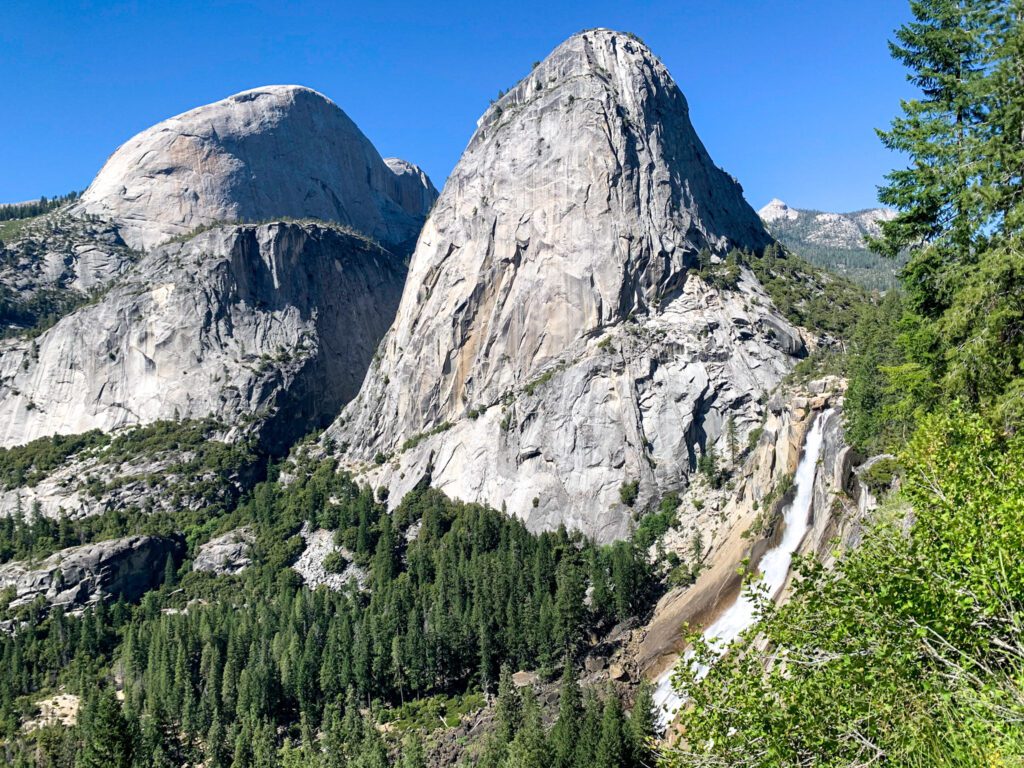
Cross the bridge over the Silver Apron and continue on another series of steps and switchbacks until you reach the top of the Mist Trail. You’ll hit a junction with the John Muir Trail shortly before you get to a bridge overlooking Nevada Falls.
There’s a short spur trail just before the bridge that leads to an overlook of the falls. Be careful at the edge. Return on the John Muir trail. Not only does it give you different views, but it’s also safer going down than the Mist Trail as it’s less steep, though it adds about 1.5 miles to your overall hike.
More trail information and recent trail reports here
Upper Yosemite Falls
7.2 miles, 3,000 feet elevation gain, difficult
This hike takes you to the top of the highest waterfall in North America (though it is technically three separate falls).
Find the trailhead near Camp 4. The hike starts up with a series of short but steep switchbacks. After about 1.2 miles and 1,200 feet, you’ll reach Columbia Rock, which offers great valley views. Many people turn around at this spot.
If you continue further, you’ll reach the top of Lower Yosemite Falls. The switchbacks continue after that until topping out after 3 miles. Go right at the junction to reach the Upper Yosemite Falls Overlook.
If you have the stamina, continue on another 1.5 miles and 500 feet to Yosemite Point for expansive views of the valley, Half Dome, North Dome, Clouds Rest, Glacier Point, and Lost Arrow.
More trail information and recent trail reports here
Inspiration Point
2.3 miles, 1,000 feet elevation gain, moderate
This hike will let you get away from the crowds at Tunnel View. It’s steep but fairly short.
Start at the upper Tunnel View parking lot and climb up a series of switchbacks. Enjoy great views of Bridalveil Falls. About halfway up, you’ll cross the old and overgrown Wawona Road.
Continue on until you reach the large, flat, and open expanse of Inspiration Point. It’s a good place to enjoy a picnic or snack. For even better views, head to the cliffs a bit further west of the point.
More trail information and recent trail reports here
Sentinel Dome and Taft Point Loop
5 miles, 1,100 feet elevation gain, easy/moderate
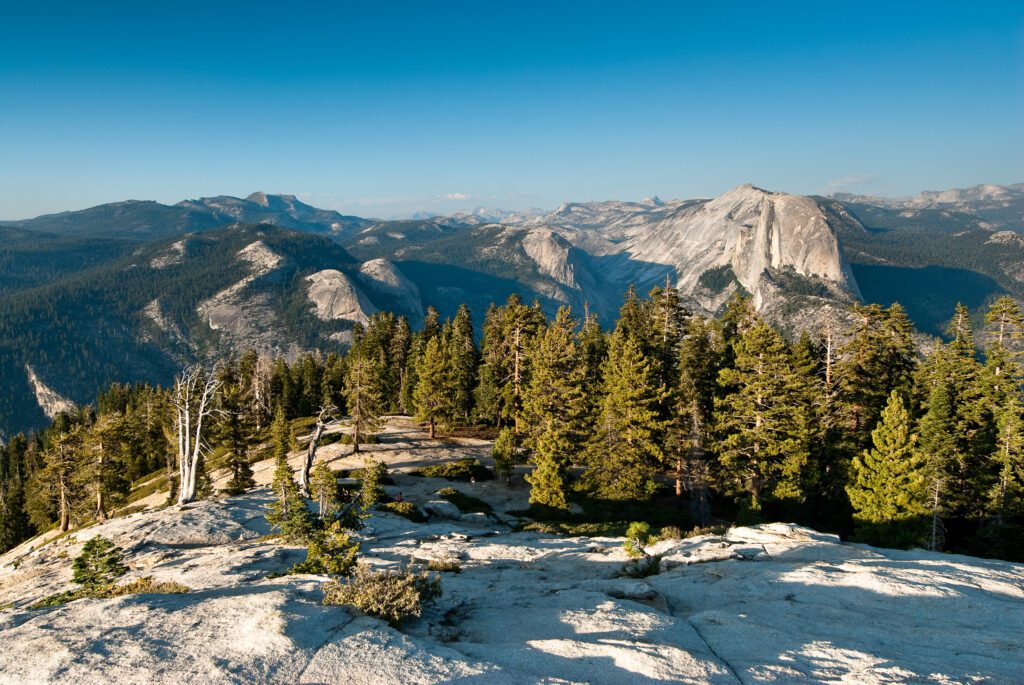
Combine two popular hikes and viewpoints in this one loop, or choose either Sentinel Dome or Taft Point if you’re short on time. Both are great for sunset.
Find the trailhead around 2 miles before the end of Glacier Point Road (here on Google Maps). Choose which direction to go based on where you want to end up (for sunset). Head right for Sentinel Dome, or left to go to Taft Point first, with a gentle descent through the forest.
Be careful when you reach the Fissures, large cracks that go straight down to the valley floor.
Just ahead is Taft Point, where there is sometimes a wait for photos. Head back the way you came until you reach a junction, and continue left on the Pohono Trail, which will cut through a lovely meadow with flowers and views of Sentinel Dome.
Right after Sentinel Creek you have the option to take a side spur to Roosevelt Point. Continue uphill until you reach the top of Sentinel Dome, and enjoy a 360-degree panoramic view of the valley and Glacier Point. Head back to the trailhead on the Sentinel Dome Trail.
More trail information and recent trail reports here
Clouds Rest
14 miles, 3,200 feet elevation gain, difficult
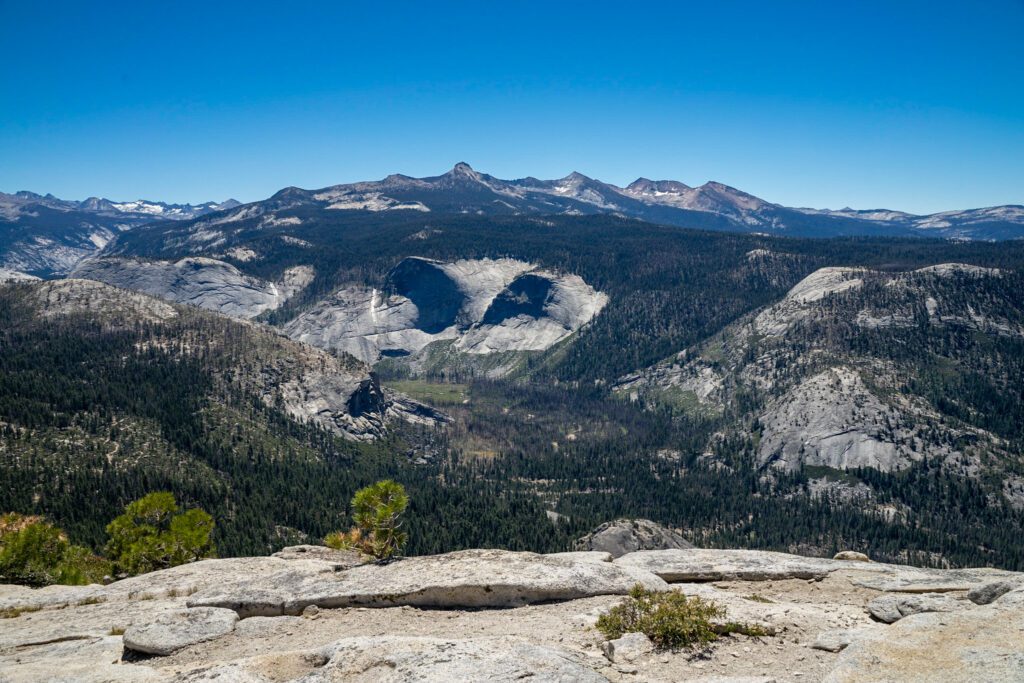
For those with the time and stamina, Clouds Rest is a great option and will take you to the top of the largest granite dome in the park.
Start at the west end of Tenaya Lake and follow the trail south towards Tenaya Lake. You’ll cross Tenaya Creek and several steep switchbacks on the eastern slope above Tenaya Canyon until you get to the top of the ridge. Follow the signs for Clouds Rest Trail and start descending until you get to a pretty meadow.
Continue south, past a pond and some small creeks, and after 2 miles, take a right and continue for 1.5 miles until the Clouds Rest foot trail. Be careful as you scramble up a narrow and exposed ridge with sheer drop offs on either side.
At the very top, take some time to appreciate the spectacular 360-degree birds eye view of Mt. Clark, Tenaya Canyon, Yosemite Valley, Half Dome, North Dome, and Sentinel Dome. It’s one of the best in the park and you definitely earned it.
More trail information and recent trail reports here
How to Get to Yosemite National Park
There are five different entrances to Yosemite: Arch Rock (Hwy 140, from the west); Big Oak Flat (Hwy 120, from the west); South/Wawona (Hwy 41, from the south); Tioga Pass (Hwy 120, from the east; summer only); Hetch Hetchy (Hwy 120, from the west; only provides access to Hetch Hetchy area).
Where you are coming from will largely dictate which entrance you use.
From San Francisco
From San Francisco, take I-80 east to I-580 east past Livermore. Take I-205 east and connect to Hwy 120 east at Manteca. Continue for 85 miles until you reach Big Oak Flat entrance.
The Hetch Hetchy entrance is just 1 mile away from the Big Oak Flat entrance. To enter at Arch Rock, take I-5 south instead of I-205 30 miles to Hwy 140 east. Continue for 105 miles until you get to Arch Rock.
From Los Angeles
From Los Angeles, take I-5 north to Hwy-99 north. At Fresno, take Hwy 41 north 65 miles to the South Wawona entrance.
From Elsewhere
If you’re planning on flying to Yosemite National Park, you actually have a surprising number of airport options to choose from. You can find rental cars at all airports.
The closest airport for year-round access to the park is Fresno Yosemite International Airport (YAT), around 2 hours away.
Sacramento and Oakland airports are around 3.5 hours away, with San Francisco and San Jose airports around 4 hours away.
Reno airport is around 3 hours away and Mammoth Airport is only 1 hour away, but both only offer access in the summer and early fall when Tioga Pass and Tioga Road are open.
You can also take the YARTS (Yosemite Area Regional Transportation System) buses to enter the park from Merced (Hwy 140) year-round, and seasonally from Sonora (Hwy 120), Fresno (Hwy 41), and Mammoth Lakes (Hwy 395). You do not need a day-use reservation if taking YARTS, but you still need to pay the entrance fee.
Getting Around Yosemite National Park
Yosemite is massive, and you really need a car to get around, and for the most flexibility. The downside of having your own vehicle is that parking can be an issue at popular spots, especially around the valley, during the peak summer season.
There is a free year-round shuttle bus that loops around Yosemite Valley on a regular basis. From mid-June to early October, a separate shuttle stops at El Capitan, Four Mile Trailhead, and the Valley Visitor Center.
Here’s the map of the route from the NPS website (more information here).
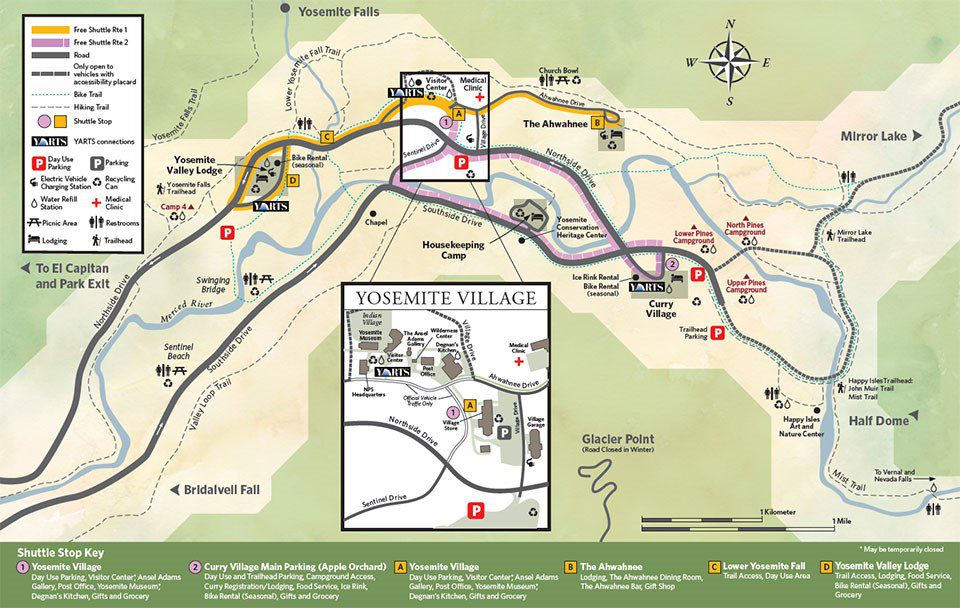
When the Badger Pass Ski Area is open (typically mid-December through March), a shuttle also runs twice daily between the valley and Badger Pass.
Paid shuttles are available to Glacier Point and Tuolumne Meadows.
Make sure to confirm shuttle status before finalizing plans that rely on them – you can see the status here.
When to Visit Yosemite National Park
Spring is the best time to visit to see waterfalls at their fullest. Tioga Road and Glacier Point may still be closed though, depending on the snowmelt. Flowers start to bloom in May. Expect crowds, though they are not as bad as in the summer. Temperatures are still cool, so bring layers for hiking and outdoor activities.
Summer is the most popular time at the park. You’ll want to book your accommodations well in advance, especially if you want to stay inside the park. Expect waits for parking spots, and crowds on trails. Waterfalls should all be flowing in early summer, though they start drying up after mid-summer. This is a good time to explore the High Sierra region off Tioga Pass Road, like Tuolumne Meadows. Smoke from wildfires may be an issue in late summer.
Fall brings fewer crowds and fall colors, which can be spectacular around mid-October. This is a great time to photograph Half Dome, El Capitan, and, along Glacier Point Road. Some of the waterfalls and lakes will be dried up at this time. Smoke from wildfires may be an issue. Temperatures will drop, so bring layers.
Winter often sees snow, turning Yosemite into a stunning winter wonderland with barely any crowds (other than over the holidays). Tioga Road and Glacier Point (to Badger Pass) will be closed. Most trails are closed as well. But you can enjoy downhill and cross country skiing, snowshoeing, and ice skating. Visit in February for Firefall, when Horsetail Falls glows at sunset as if it’s on fire.
For first-time visitors, June is the best time to visit, to see waterfalls flowing well, and have access to pretty much the entire park. Though always double check the status of Tioga Road at this time, as it may not be open for the season. Visit during the week, and early in the day, to avoid peak crowds.
Plan an Unforgettable California Adventure
Heading to California? We’ve got all sorts of super detailed, in-depth California travel guides written by locals to help you plan an amazing trip.
- San Francisco: We’ve got a guide to spending 3 days in SF, one day in San Francisco for planning a shorter trip, and a complete guide to finding the perfect place to stay in San Francisco. We also have guides to 14 perfect weekend getaways from San Francisco and the best day trips in the Bay Area. Oh, we almost forgot, here are the 15 best hikes near San Francisco, written by two Bay Area locals.
- Los Angeles: Read our perfect 2 Day L.A. itinerary, our guide to spending one amazing day in L.A. (with two versions!), and a guide to helping you figure out where to stay.
- San Diego: Learn how to spend a day in San Diego, a weekend in San Diego, and where you should stay.
- Lake Tahoe: Plan the perfect summertime adventure with our 3 day Tahoe itinerary, guide to the best hikes, and our guide to the best things to do in Tahoe.
- Santa Barbara: We have a guide to planning a weekend in Santa Barbara, and a guide to a day trip to Santa Barbara from Los Angeles if you’re pressed for time.
- Mammoth Lakes: To plan a perfect getaway in the Eastern Sierra, read our guide to the best things to do in Mammoth Lakes in the summer. Plus, our guide to the best hikes in Mammoth, featuring the epic climb to the top of Duck Pass.
- Big Sur: Plan the perfect weekend away with our complete Big Sur itinerary.
- Yosemite National Park: Plan an amazing trip with our guide to planning an amazing Yosemite itinerary, and our guide to choosing where to stay at Yosemite.
- Joshua Tree National Park: Plan the perfect trip with our perfect weekend itinerary (or a day trip, if you have less time), a guide to the best hikes, and some cool places to stay in Joshua Tree.
- Death Valley National Park: We have a SUPER detailed guide to planning the perfect Death Valley itinerary, and a guide to the best hikes in Death Valley National Park.
- California Road Trips: See the best of the Pacific Coast Highway on our San Francisco to San Diego road trip, or make the trip up Highway from on a Los Angeles to SanFrancisco road trip. If you’re more into mountains than beaches, a Highway 395 road trip from Los Angeles to Lake Tahoe might be more your speed.

